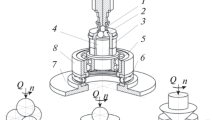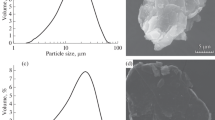Abstract
On the basis of theoretical and experimental results, a formula including generalized characteristics for the wear rate of industrial ceramics is developed. The derivation of the formula takes account of the mechanical and thermophysical properties of the ceramic; the crack resistance, stress-strain state and temperature state of the frictional bodies; and the influence of the surroundings. The formula is compared with those that already exist.
Similar content being viewed by others
References
Bolotin, V.V., Mekhanika razrusheniya kompozitov. Kompozitnye materialy. Spravochnik (Failure Mechanics of Composites: A Handbook), Moscow: Mashinostroenie, 1990, pp. 158–188.
Morozov, E.M. and Zernin, M.V., Kontaktnye zadachi mekhaniki razrusheniya (Contact Problems of Failure Mechanics), Moscow: Mashinovedenie, 1999.
Mekhanika kontaktnykh vzaimodeistvii (Mechanics of Contact Interactions), Vorovich, I.I. and Aleksandrov, V.M., Eds., Moscow: Fizmatlit, 2001.
Drozdov, Yu.N., Key Invariants when Calculating Wear Rates in Friction, Mashinovedenie, 1980, no. 2, pp. 93–98.
Evans, A.G. and Wilshaw, T.R., Quasi-Static Solid Particle Damage in Brittle Solids. 1. Observations, Analysis, and Implications, Acta Met., 1976, vol. 24, no. 10, pp. 939–956.
Lawn, B.R., Evans, A.G., and Marshall, D.P., Elastic/Plastic Indentation Damage in Ceramics: The Median/Radial Crack System, J. Am. Ceram. Soc., 1982(63), no. 9–10, pp. 574–581.
Kim, S.S., Kato, K., Hokkirigawg, K., and Abe, H., Wear Mechanism of Ceramic Materials in Dry Rolling Friction, J. Tribol., Trans. ASME, 1986, vol. 108, pp. 522–526.
Kim, S.S., Kim, S.W., and Hsu, S.M., A New Parameter for Assessment of Ceramic Wear, Wear, 1994, vol. 179, pp. 69–73.
Garshin, A.P., Gropyanov, V.M., Zaitsev, G.P., et al., Keramika dlya mashinostroeniya (Ceramics for Manufacturing), Moscow: OOO Izd. Nauchtekhlitizdat, 2003.
Hsu, S.M. and Shen, M., Wear Prediction of Ceramics, Wear, 2004, vol. 256, pp. 867–878.
Drozdov, Yu.N. and Savinova, T.M., Deriving Formulas for Ceramic Wear by a Theoretical-Invariant Method, Probl. Mashinostr. Nadezhn. Mashin, 2006, no. 2, pp. 60–68.
Drozdov, Yu.N. and Savinova, T.M., Tribological Invariants for Industrial Ceramics, Vestn. Mashinostr., 2006, no. 7, pp. 25–30.
Drozdov, Yu.N., Khurshudov, A.G., and Panin, V.I., Selecting Ceramics for Cam-Tappet Pair, Trenie Iznos, 1991, vol. 14, no. 3, pp. 479–486.
Metselaar, H.S.C., Winnubst, A.J.A., and Schipper, D.J., Thermally Induced Wear of Ceramics, Wear, 1999, vol. 225–229, pp. 857–861.
Le, T.H., Kim, S.S., and Chae, Y., Sliding Wear Behavior of Plasma Sprayed Zirconia Coating, Int. Symp. High-Performance Tribo-Systems, Daegu, Korea, 2004.
Author information
Authors and Affiliations
Additional information
Original Russian Text © Yu.N. Drozdov, V.A. Nadein, T.M. Savinova, 2008, published in Vestnik Mashinostroeniya, 2008, No. 6, pp. 39–42.
About this article
Cite this article
Drozdov, Y.N., Nadein, V.A. & Savinova, T.M. Predicting the frictional wear rate of industrial ceramics. Russ. Engin. Res. 28, 554–558 (2008). https://doi.org/10.3103/S1068798X08060099
Published:
Issue Date:
DOI: https://doi.org/10.3103/S1068798X08060099




